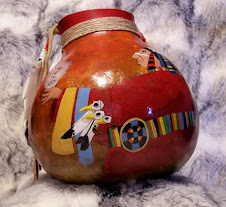"What are you working on now"?
I now invite you into my studio to see what's on the easel.
Most artists are funny about showing work that is not completed. Looking at an unfinished piece you get to see the mistakes, the re-works and you have to remember that the painting may change before it is completed. It's like an author writing a story. The story may change several times before it is finished.

This painting is 30 x 40 on stretched canvas and depicts a trio of hunting wolves. I have been working on this painting for quite some time. My painting time has been greatly reduced due to the Parkinson's disease. When I have a day with no or just minor tremors I have to take advantage of it and work as long as I can.
These three wolves have picked up the scent of a rabbit. The rabbit is hiding in the hollow log in the foreground of the painting. Over to the left, two wolves are standing, watching for some movement.

What is interesting about these two wolves is that wherever you move in the room, not only do their eyes follow you, their entire heads turn and follow your movements. I hope you can move your head from side to side and see that ,indeed, their heads do turn.
I hope you don't get caught moving back and forth at your computer . . . your sanity might be questioned.

The larger wolf in the middle ground has picked up the scent of the rabbit but has been interrupted by the presence of YOU the viewer.
The eyes of this wolf follow you as you move about the room, although the head remains straight forward.
There is alot of work to complete on this painting and many problems to solve. Do you show the rabbit in the hollow log? or not and let it be part of the viewer's imagination? Do you add any more wolves? Many questions to be answered and many problems to be worked out.
This next painting is just about finished. On a stretched 24 x 36 canvas it shows seventeen pelicans and is appropriately titled; "Seventeen Pelicans". I need to finish the pelicans in the foreground and add a little more detail to some of the other pelicans.
Have you found yourself "counting" the pelicans ?
The viewer is automatically drawn into the painting by counting pelicans.
What?
There are only 15 ?
I guess two flew away.

This 30 x 40 stretched gallery canvas shows
Iris . . . . . this was going to be my entry for the
ESMarts team September challenge.
Tremors kept me from getting it done in time.
Oh well, maybe next time.

This 30 x 40 painting of a frog diving below the water is a "toughie". It is painted from a view below the subject, looking up.
Above the frog will be seen the shadow of a Heron.
"The Great Escape" as a title will tell the story for the viewer in just a few words.

I don't know if it is that enjoy a tough challenge or that I am a glutton for punishment.
Besides all the visual problems in completing this painting . . . who wants a painting of an expensive frog hanging on their wall ?
I do have to admit I am enjoying working on this one. Doing all the little air bubbles under the water, caused by the splash of the frog, should really be fun.

The last painting I have on the easel is a 18x24
stretched canvas entitled
"Spirit of the Eagle Dancer "

I love doing pieces like this, it's just in my blood.
This will be posted on my Etsy store . . . .
http://kickingbear.etsy.com/
Well, so much for what I have on the easel. When these will be completed, I have no idea.
At least you can see that I am not just sitting around feeling sorry for myself. I welcome your comments about what I have on the easel and any thoughts you have.
Be sure to take a look at my Etsy store . . . http://coastalartist.etsy.com/









